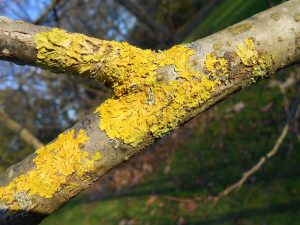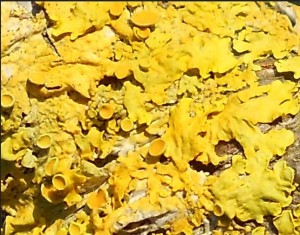Take a look around when the sun is low in the sky and lighting up the lichens on deciduous tree bark. Xanthoria parietina can be found on the bark of Tapiscia sinensis it also grows throughout the arctic, adding a much needed splash of colour to the white surroundings. The Polar Inuit of Northern Greenland call it “sunain anak”, meaning the sun’s excrement.
Currently, X. parietina, is one of the commonest lichens in the UK as it loves nitrogen pollution. It especially likes to live near roads and in cities and is used as an indicator of (poor) air quality. The good news though, is that we also have clean air/nitrogen sensitive lichens growing in the Garden such as Evernia prunastri . Evernia is also used as an indicator of air quality. Xanthoria has been used as a dye to colour many things from fabric to Easter eggs.
Strange we have both but I think that it is the range of tree species growing in the Garden that can explain it – the pH of tree bark has a massive impact on lichen distribution with some lichens liking high pH e.g. Xanthoria and others loving low pH. Trees with naturally high pH (like the Tapiscia sinensis) are more likely to support Xanthoria than those with a low pH (such as pines). The wide range of trees at RBGE means the Garden can support a great range of lichens too.


